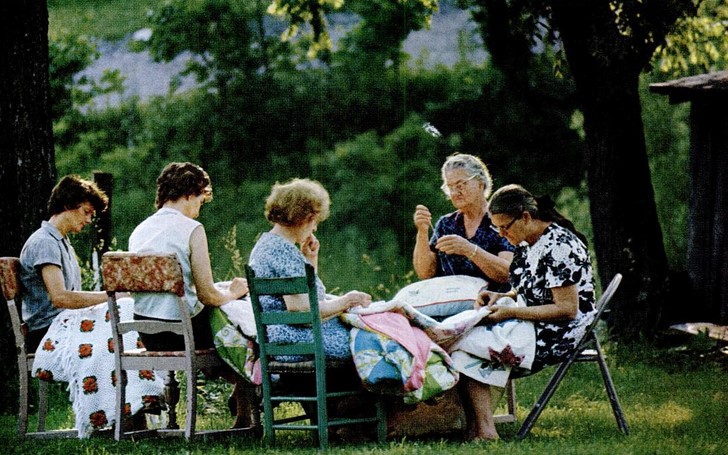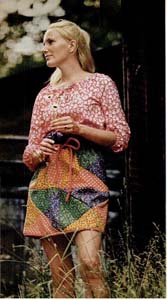This picture portrays a West Virginia coop turning old quilts into new items. If you look carefully, it appears that the oldest woman in the back on the right is hand stitching a pillow, while the woman at the far left seems to be sewing quilt motifs on to a blanket.
Cutting up old quilts for new clothes is in the news again, as quilted items are in style. This has sparked a debate among quilters, seamsters, and designers about whether or not it is appropriate to use these handmade items for a different purpose. Some makers of quilted clothing defend their practice by insisting that they are giving a new life to worn and discarded objects. Those who oppose the practice insist that they are cutting into historically relevant pieces of women’s history. Listen to a passionate argument against the practice, “Quilt Clothes Must Die” by quilt expert Mary Fons.
The women pictured above were in it for the money. As the article explains, the clothes made from the quilts they cut up were popular in the fashion industry. They only earned a dime an hour making quilts for collectors or museums, but with help from their coop they were earning $2 an hour working for fashion designers. Of course most of the profit was at the other end–eventually the patchwork mini skirt above sold for $35.
Even though the women are destructing rather than making quilts, the picture is reminiscent of an old time quilting bee. The oldest woman, still handy with a needle, wears a simple dress, perhaps a shirtwaist style. The middle aged women to her left also have on simple clothes, with no hint at all of current styles. The most interesting seamstress of all is the one on the far right, who looks like she might be Native American. She is wearing a more contemporary shift dress with a bold pattern.
I’ll leave you to decide whether or not to cut up quilts for clothing. Personally, I think we should follow Mary Fons’s suggestion. If you want clothes made from quilts, make the quilt yourself.




Old quits get frayed. I don’t seem any harm to giving the fabrics a third life. Seems really useful to me.
I agree. Not everything old has historical significance anyway. Some old stuff is just old and worn out. It’s better to reuse and recycle old quilts into clothing and into fiber art. Plus, old quilts have a patina and softness that it will take decades to achieve with new quilting.
An old, faded, frayed quilt is unlikely to be a candidate for refashioning into a garment.
I immediately thought, “That’s from Mountain Artisans!” That thought was confirmed when I clicked through to the story. The Mountain Artisans Quilting Book was a best-seller and a Book-of-the-Month Club selection. Old-quilts-into-new-clothes comes along every couple of seasons. What alarms/astounds me is the huge price such clothes command–though when I opined that on a FB post I was scolded for trying to deny fair wages to the people who sewed those designer duds. And, yes, duds in another sense — because that fashion will go out of fashion in the blink of a season. What will happen to that $800 made-from-an-old-quilt jacket?
There are several scenarios. It could get donated to a charity shop, then resold to a fiber artist, who could transform it again. It could be sold on eBay or Poshmark. It could be passed down to a daughter or niece. Or it could be kept and reworn by the original owner, who might not care about how “fashionable” it is.
Thank you for the video by Mary Fons. It’s a thorny issue.